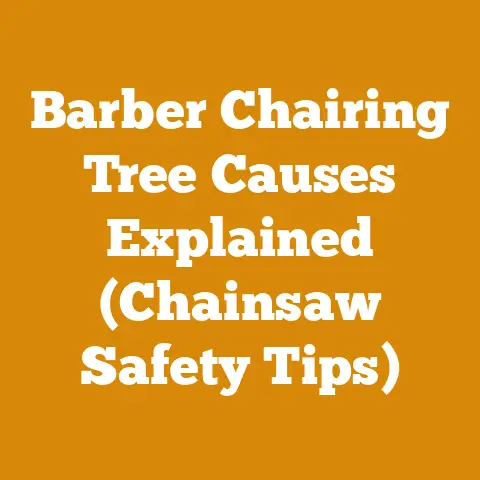West Coast Saw Raker Gauge: Precision Depth Control (5 Pro Tips)
Achieving the Perfect Bite: Mastering Raker Depth with the West Coast Saw Raker Gauge
As someone who has spent countless hours in the woods, wrestling with logs and coaxing the most out of my chainsaw, I can tell you that achieving the perfect cut isn’t just about a sharp chain. It’s about precision, and that precision starts with the rakers. Rakers, also known as depth gauges, control how deeply each cutter bites into the wood. Setting them correctly is the secret to smooth cuts, efficient sawing, and extending the life of your chain. A West Coast Saw Raker Gauge, in my experience, is one of the best tools to achieve this precision. Let me share five pro tips to help you master raker depth control.
Understanding Rakers and Their Importance
Before diving into the tips, let’s clarify what rakers are and why they matter so much.
Rakers sit just ahead of each cutting tooth on your chainsaw chain. Their height determines how much wood the cutter can remove with each pass.
Too high, and the cutter barely scratches the surface, resulting in slow cutting, excessive vibration, and increased wear on the chain and saw.
Too low, and the cutter takes too big of a bite, leading to aggressive cutting, potential kickback, and a rough, uneven finish.
The goal is to find that sweet spot where the cutter removes the optimal amount of wood for efficient and safe sawing.
Tip 1: Choosing the Right Gauge for Your Chain
The first step to mastering raker depth control is selecting the correct gauge for your specific chain. Raker gauges aren’t one-size-fits-all. They are designed to match the pitch and gauge of your chainsaw chain.
- Pitch: This refers to the distance between three rivets on the chain, divided by two. Common pitches include .325″, 3/8″, and .404″.
- Gauge: This is the thickness of the drive links that fit into the guide bar groove. Common gauges include .050″, .058″, and .063″.
Using the wrong gauge can lead to inaccurate raker settings and compromise cutting performance.
How to Determine Your Chain’s Pitch and Gauge:
- Check the Chain: Many chains have the pitch and gauge stamped directly on the drive links. Look closely for these markings.
- Consult Your Chainsaw Manual: The manual will specify the recommended chain for your saw, including pitch and gauge.
- Measure Manually: If you can’t find the information elsewhere, you can measure the pitch and gauge yourself using a caliper or ruler.
Once you know your chain’s specifications, you can select the appropriate West Coast Saw Raker Gauge. They typically offer gauges designed for different pitch and gauge combinations.
Personal Experience: I once tried to use a gauge designed for a .325″ pitch chain on a 3/8″ pitch chain. The results were disastrous. The rakers were set far too low, leading to aggressive cutting and frequent kickback. I quickly realized the importance of using the correct gauge.
Takeaway: Always verify your chain’s pitch and gauge before selecting a raker gauge. Using the wrong gauge can lead to inaccurate raker settings and unsafe cutting conditions.
Tip 2: Mastering the Filing Technique
Once you have the correct gauge, the next step is mastering the filing technique. This involves using a flat file to carefully lower the rakers to the desired height.
Tools You’ll Need:
- West Coast Saw Raker Gauge
- Flat File (8-10 inches long)
- File Holder (optional, but recommended for better control)
- Gloves
- Eye Protection
Step-by-Step Filing Process:
- Secure the Chain: Place the chain in a vise or clamp to hold it securely in place. This will prevent movement and ensure consistent filing.
- Position the Gauge: Place the gauge on the chain so that the raker protrudes through the opening in the gauge. The gauge should sit flush against the tie straps.
- File the Raker: Hold the flat file flat against the gauge and file the raker until it is flush with the top of the gauge. Use smooth, even strokes, applying light pressure.
- Check Your Work: Remove the gauge and inspect the raker. It should be flat and even.
- Repeat: Repeat the process for each raker on the chain.
Key Considerations:
- File Angle: Maintain a consistent file angle throughout the process. A slight downward angle is generally recommended.
- File Pressure: Avoid applying too much pressure, as this can damage the raker or the file. Let the file do the work.
- File Sharpness: Use a sharp file for best results. A dull file will require more pressure and can lead to uneven filing.
- Consistency: Strive for consistency in your filing technique. This will ensure that all rakers are set to the same height.
Personal Experience: I initially struggled with maintaining a consistent file angle. My rakers ended up being slightly uneven, which affected the cutting performance of my chain. I found that using a file holder helped me maintain a more consistent angle and improved my filing accuracy.
Takeaway: Practice your filing technique to achieve consistent and accurate raker settings. A file holder can be a valuable tool for maintaining a consistent file angle.
Tip 3: Understanding Different Raker Depths for Various Wood Types
Not all wood is created equal. Different wood types have different densities and hardness levels, which can affect the optimal raker depth.
- Softwoods (Pine, Fir, Cedar): Softwoods are easier to cut and require shallower raker depths. This allows the cutter to remove a smaller amount of wood with each pass, preventing the chain from bogging down.
- Hardwoods (Oak, Maple, Hickory): Hardwoods are denser and more difficult to cut, requiring deeper raker depths. This allows the cutter to remove a larger amount of wood with each pass, increasing cutting efficiency.
Adjusting Raker Depth Based on Wood Type:
- Softer Woods: Use a raker gauge with a slightly higher setting to reduce the depth of cut.
- Harder Woods: Use a raker gauge with a slightly lower setting to increase the depth of cut.
Example: If I’m cutting pine, I might use a raker gauge with a setting of .025″. If I’m cutting oak, I might use a gauge with a setting of .030″.
Personal Experience: I once tried to cut oak with rakers set for pine. The chain struggled to bite into the wood, and the saw vibrated excessively. I quickly realized that I needed to adjust the raker depth for the harder wood.
Takeaway: Adjust your raker depth based on the type of wood you’re cutting. Softer woods require shallower raker depths, while harder woods require deeper raker depths.
Tip 4: Fine-Tuning Rakers for Optimal Performance
Even with the correct gauge and proper filing technique, you may need to fine-tune your rakers to achieve optimal performance. This involves making small adjustments to the raker height based on your specific cutting conditions and preferences.
Signs That Your Rakers Need Fine-Tuning:
- Chain Chatter: If the chain chatters or vibrates excessively, the rakers may be too high.
- Slow Cutting: If the chain cuts slowly, the rakers may be too high.
- Aggressive Cutting: If the chain cuts aggressively and kicks back easily, the rakers may be too low.
- Rough Finish: If the cut surface is rough and uneven, the rakers may be too low.
How to Fine-Tune Your Rakers:
- Lower Rakers: If the rakers are too high, use the flat file to carefully lower them a small amount.
- Raise Rakers: If the rakers are too low, you can use a specialized raker raising tool or carefully peen the raker with a hammer and punch to raise its height. However, this is a more advanced technique and should only be attempted by experienced users.
Important Considerations:
- Make Small Adjustments: When fine-tuning your rakers, make small adjustments and test the chain after each adjustment.
- Test in the Wood: The best way to determine if your rakers are properly set is to test the chain in the type of wood you’ll be cutting.
- Document Your Settings: Keep a record of your raker settings for different wood types and cutting conditions. This will save you time and effort in the future.
Personal Experience: I often fine-tune my rakers based on the specific tree I’m cutting. If I encounter a particularly knotty or dense section of wood, I might lower the rakers slightly to improve cutting performance.
Takeaway: Fine-tune your rakers based on your specific cutting conditions and preferences. Make small adjustments and test the chain after each adjustment.
Tip 5: Maintaining Your Raker Gauge and Files
Like any tool, your raker gauge and files require proper maintenance to ensure accurate and reliable performance.
Raker Gauge Maintenance:
- Clean Regularly: Clean your raker gauge after each use to remove sawdust, debris, and oil.
- Inspect for Damage: Regularly inspect your raker gauge for any signs of damage, such as cracks, bends, or worn edges. Replace the gauge if it is damaged.
- Store Properly: Store your raker gauge in a clean, dry place to prevent rust and corrosion.
File Maintenance:
- Clean Regularly: Clean your files after each use with a file card or wire brush to remove filings and debris.
- Store Properly: Store your files in a dry place to prevent rust. Consider using a file holder or case to protect the files from damage.
- Sharpen or Replace: Files will eventually become dull with use. You can sharpen them using a file sharpener or replace them when they become too dull.
Personal Experience: I neglected to clean my raker gauge once, and it accumulated a layer of sawdust and oil. This affected the accuracy of the gauge and made it difficult to set the rakers properly. I learned my lesson and now make sure to clean my gauge after each use.
Takeaway: Maintain your raker gauge and files to ensure accurate and reliable performance. Clean them regularly, inspect them for damage, and store them properly.
Conclusion: Mastering Raker Depth for Peak Performance
Mastering raker depth control is essential for achieving peak performance from your chainsaw. By choosing the right gauge, mastering the filing technique, understanding different raker depths for various wood types, fine-tuning your rakers, and maintaining your tools, you can ensure smooth cuts, efficient sawing, and extended chain life.
Remember, practice makes perfect. Don’t be afraid to experiment with different raker settings to find what works best for you and your chainsaw. With a little patience and attention to detail, you’ll be able to achieve the perfect bite every time.
Now, get out there and put these tips into practice! You’ll be amazed at the difference properly set rakers can make. Happy sawing!






